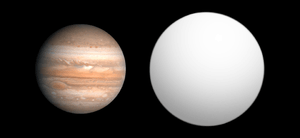HAT-P-4b
| Exoplanet | List of exoplanets | |
|---|---|---|
 | ||
| Parent star | ||
| Star | HAT-P-4 | |
| Constellation | Boötes | |
| Right ascension | (α) | 15h 19m 57.9205s[1] |
| Declination | (δ) | +36° 13′ 46.7380″[1] |
| Distance | 1055±9[1] ly (323±3[1] pc) | |
| Spectral type | F | |
| Orbital elements | ||
| Semi-major axis | (a) | 0.04449+0.00083 −0.0012[2] AU |
| Eccentricity | (e) | <0.0073[2] |
| Orbital period | (P) | 3.0565254±0.0000012[3] d |
| Inclination | (i) | 89.9 +0.1 −2.2° |
| Time of transit | (Tt) | 2454245.81521±0.00020[3] JD |
| Semi-amplitude | (K) | 78.6+2.4 −2.3[2] m/s |
| Physical characteristics | ||
| Mass | (m) | 0.651+0.033 −0.037[2] MJ |
| Radius | (r) | 1.27 ± 0.05 RJ |
| Density | (ρ) | 410 ± 60 kg m−3 |
| Surface gravity | (g) | 10.5 m/s² |
| Discovery information | ||
| Discovery date | Oct 2, 2007 | |
| Discoverer(s) | Kovacs et al. | |
| Discovery method | transit | |
| Discovery site | Mass., | |
| Discovery status | Published[4] | |
| Database references | ||
| Extrasolar Planets Encyclopaedia | data | |
| SIMBAD | data | |
| Exoplanet Archive | data | |
| Open Exoplanet Catalogue | data | |
HAT-P-4b is a confirmed extrasolar planet orbiting the star HAT-P-4 over 1000 light years away in Boötes constellation. It was discovered by transit on October 2, 2007, which looks for slight dimming of stars caused by planets that passed in front of them. It is the fourth planet discovered by the HATNet Project.[4] It is also called BD+36 2593b, TYC 2569-01599-1b, 2MASS J15195792+3613467b, SAO 64638b.
It is a hot Jupiter with 68% the mass and 127% the radius of Jupiter, and 41% the density of water (31% of Jupiter). Since the inclination is known by transit observation, the true mass is known. The secondary eclipse where the planet passes behind the star was detected by the Spitzer space telescope leading to the discovery that the planet has inefficient heat transfer from its day to night side.[5]
References
- 1 2 3 4 Brown, A. G. A.; et al. (Gaia collaboration) (August 2018). "Gaia Data Release 2: Summary of the contents and survey properties". Astronomy & Astrophysics. 616. A1. arXiv:1804.09365. Bibcode:2018A&A...616A...1G. doi:10.1051/0004-6361/201833051. Gaia DR2 record for this source at VizieR.
- 1 2 3 4 Bonomo, A. S.; et al. (2017). "The GAPS Programme with HARPS-N at TNG . XIV. Investigating giant planet migration history via improved eccentricity and mass determination for 231 transiting planets". Astronomy and Astrophysics. 602. A107. arXiv:1704.00373. Bibcode:2017A&A...602A.107B. doi:10.1051/0004-6361/201629882.
- 1 2 Sada, Pedro V.; et al. (2012). "Extrasolar Planet Transits Observed at Kitt Peak National Observatory". Publications of the Astronomical Society of the Pacific. 124 (913): 212–229. arXiv:1202.2799. Bibcode:2012PASP..124..212S. doi:10.1086/665043. JSTOR 10.1086/665043.
- 1 2 Kovács, G.; et al. (2007). "HAT-P-4b: A Metal-rich Low-Density Transiting Hot Jupiter". The Astrophysical Journal Letters. 670 (1): L41–L44. arXiv:0710.0602. Bibcode:2007ApJ...670L..41K. doi:10.1086/524058.
- ↑ Todorov, Kamen O.; et al. (2013). "Warm Spitzer Photometry of Three Hot Jupiters: HAT-P-3b, HAT-P-4b and HAT-P-12b". The Astrophysical Journal. 770 (2). 102. arXiv:1305.0833. Bibcode:2013ApJ...770..102T. doi:10.1088/0004-637X/770/2/102.
External links
![]()
Coordinates: ![]()